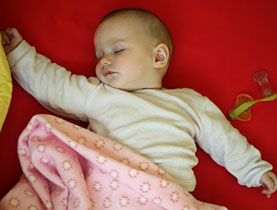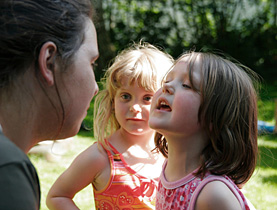Family-friendly cantons end birth rate decline

A handful of Swiss cantons has slowed trends in declining birth rates by improving child care facilities and offering higher family allowances, a study has found.
Giuliano Bonoli, of the Institute of Advanced Studies in Public Administration in Lausanne, reviewed changes in the birth rate in 26 cantons between 1980 to 2000, in a study published in the Journal of European Social Policy.
The cantons of Geneva, Vaud, Neuchâtel, Basel City and Zurich managed to maintain the number of births at 1980 levels or even increase birth rates. All are among the cantons offering more day care for children and awarding comparatively higher family allowances.
“People living in those cantons where it is relatively easier or more acceptable to be both a mother and a worker tend to have more children,” Bonoli told swissinfo.
“My interpretation of these results is not so much that women or parents decide to have a child once they have found that they have a day care centre.
“I don’t think that such irrational calculations are behind decisions to have children, but I think these indicators of family policy are also indicators of a more favourable climate for the reconciliation of work and family.”
Working women
The study was undertaken against a backdrop of low fertility rates in most member countries of the Organisation for Economic Cooperation and Development.
Bonoli says that if current fertility trends continue over the next several decades it will lead to dramatic population decline and ageing in these countries.
In Switzerland most cantons reported falling birth rates between 1980 and 2000, which Bonoli attributes to an evolving society, with more women joining the workforce.
“We did this study because we realised that there were big differences in fertility rates across the Swiss cantons. The differences are on a scale comparable to those one finds across Europe,” said Bonoli.
“The most powerful variation is the number of day care centres per 1,000 of working women. A second indicator also found to be positively related and statistically significant is a composite indicator of the generosity of child allowances.”
Bonoli says that the Swiss study offered “almost laboratory-like conditions”, with broadly similar living and labour status across the country making the results less subject to variables.
He found that the monthly amount of standard child benefit varied between SFr150-300 ($125-250) depending on the canton. Inter-cantonal differences in family benefits have been stable over the last two decades, which allowed for more reliability in reviewing that as a factor in fertility rates.
He said it was possible that the level of family benefits did not matter as much for the first or second child, but became more relevant for the third or fourth.
Priority
Birth rates in 2003 ranged between a low of 1.17 children per woman in the Italian-speaking canton of Ticino and 1.71 in the German-speaking, rural and strongly Catholic canton of Appenzell Inner Rhodes. The latter had a sharp decline from 2.53 in 1980 to the current level. The same pattern of constant decline was found in the majority of cantons.
Birth rates were also found to be affected by the modernisation of society, with fewer births among working women, and the gradual abandonment of agricultural professions. Birth rates are traditionally higher in farming families.
The results confirm findings in previous research of certain countries that have bucked trends and seen fertility rates increase. Studies of increases in Nordic countries, France and the United States show all had efficient child care systems.
Bonoli suggests that a favourable social policy for families will not only help avoid financial problems in the pensions system, but it also favours women. He cites 2001 research that found women, on average, in low fertility countries wanted more children.
“A positive effect on fertility can be obtained by simply meeting the demands of women and families in the field of reconciling work and family life,” he said.
“These results contribute towards showing that it is an important priority for Switzerland, as it is for other western European countries, to invest in child care.”
swissinfo, Jessica Dacey
Formal day care centres per 1,000 female jobs (2004)
Geneva: 1.87
Neuchâtel: 1.18
Zurich: 1.16
Vaud: 0.71
Basel City: 0.67
Jura: 0.63
Schaffhausen: 0.50
Bern: 0.43
Fribourg: 0.42
Solothurn: 0.40
Basel Country: 0.40
Glarus: 0.39
Aargau: 0.37
Valais: 0.32
St Gallen: 0.32
Lucerne: 0.32
Ticino: 0.31
Schwyz: 0.30
Appenzell Outer Rhodes: 0.29
Nidwalden: 0.26
Thurgau: 0.24
Zug: 0.18
Graubünden: 0.17
Uri: 0.16
Obwalden: 0.15
Appenzell Inner Rhodes: 0
Source: The impact of social policy on fertility: evidence from Switzerland, published in the Journal of European Social Policy.

In compliance with the JTI standards
More: SWI swissinfo.ch certified by the Journalism Trust Initiative




You can find an overview of ongoing debates with our journalists here. Please join us!
If you want to start a conversation about a topic raised in this article or want to report factual errors, email us at english@swissinfo.ch.